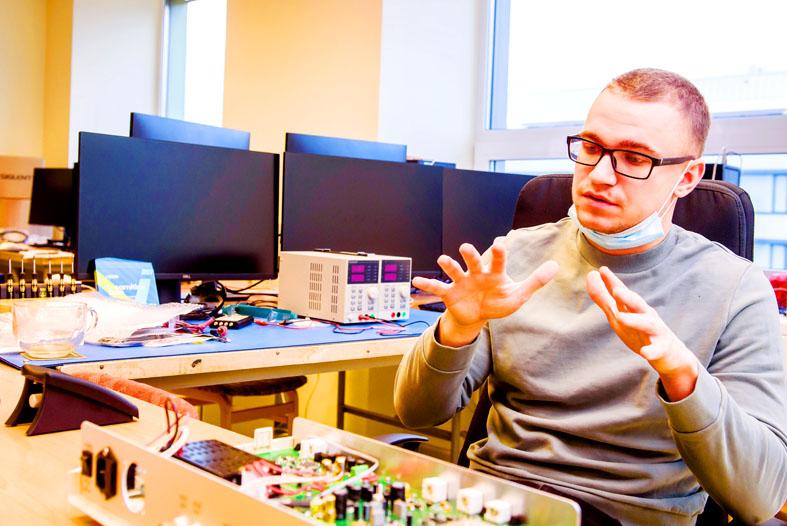In a corner of the campus at Riga Technical University, a team of scientists is working on technology that could one day stop asteroids from smashing into Earth.
The high-precision timers being built by hand in the laboratory of Latvian start-up Eventech are currently being used to track satellites.
The company earlier this year won a European Space Agency (ESA) contract to develop timers that would study the possibility of redirecting an asteroid before it comes too close to our planet for comfort.

Photo: AFP
NASA plans to launch the first part of the Asteroid Impact and Deflection Assessment mission — known as the Double Asteroid Redirection Test — on July 22 next year on a Space X Falcon 9 rocket.
The 500kg camera-equipped probe is to fly to an asteroid named Didymos and smash into it, trying to blow it off its current course that will see it pass near Earth sometime in 2123.
Eventech’s deep space event timers are being developed for the follow-up HERA mission, which is planned to launch five years later, to determine if the first mission succeeded.
“Our new technology that will follow on the second ESA spacecraft named HERA will measure if the first impact steered the kilometer-sized Didymos off its previous course, avoiding harm to humanity,” Eventech engineer Imants Pulkstenis said.
“It’s much more interesting to boldly go where no man has gone before than to manufacture some mundane consumer electronics for huge profit,” he added, borrowing the famous slogan from Star Trek, the 1960s science fiction TV series.
Eventech’s timers are part of a space technology tradition in the Baltic state stretching back to Soviet times when Sputnik — the first manufactured satellite to orbit the Earth — was launched in 1957.
They measure the time needed for an impulse of light to travel to an object in orbit and back.
Eventech devices can record the measurement to within a picosecond — or one-trillionth of a second — which allows astronomers to convert a time measure into a distance measurement with up to 2mm of precision.
About 10 of the timers are produced every year and they are used in observatories around the world.
They track Earth’s increasingly crowded atmosphere, filled with a new crop of private satellites alongside traditional scientific and military ones.
“Tracking them all requires tools,” Eventech chief operations officer Pavels Razmajevs said.
Eventech’s engineers said that they use analogue parts as much as possible, mainly because microchips take nanoseconds to compute the signal, which is too long for incoming measurements ranging in picoseconds.
While these timers are used for calculations on Earth, a different appliance for space missions is being developed in another corner of the same laboratory to track planetary objects from a moving space probe.
“There is no GPS data coverage available on other planets, so you have to take your own precision ranging with you,” Pulkstenis said.
Developing devices for space would be a complex task, but one Eventech’s engineers are relishing.
“Our updated technology has to withstand extreme temperatures in space and extreme cosmic radiation,” Pulkstenis said. “It’s a fun challenge.”

CHARGES: The former president, who maintains his innocence, was sentenced to 27 years and three months in prison for a failed coup bid, as well as an assassination plot Far-right former Brazilian president Jair Bolsonaro is running out of options to avoid prison, after judges on Friday rejected his appeal against a 27-year sentence for a botched coup bid. Bolsonaro lost the 2022 elections and was convicted in September for his efforts to prevent Brazlian President Luiz Inacio Lula da Silva from taking power after the polls. Prosecutors said the scheme — which included plans to assassinate Lula and a top Brazilian Supreme Court judge — failed only due to a lack of support from military top brass. A panel of Supreme Court judges weighing Bolsonaro’s appeal all voted to uphold

DISASTER: The Bangladesh Meteorological Department recorded a magnitude 5.7 and tremors reached as far as Kolkata, India, more than 300km away from the epicenter A powerful earthquake struck Bangladesh yesterday outside the crowded capital, Dhaka, killing at least five people and injuring about a hundred, the government said. The magnitude 5.5 quake struck at 10:38am near Narsingdi, Bangladesh, about 33km from Dhaka, the US Geological Survey (USGS) said. The earthquake sparked fear and chaos with many in the Muslim-majority nation of 170 million people at home on their day off. AFP reporters in Dhaka said they saw people weeping in the streets while others appeared shocked. Bangladesh Interim Leader Muhammad Yunus expressed his “deep shock and sorrow over the news of casualties in various districts.” At least five people,

The latest batch from convicted sex offender Jeffrey Epstein’s e-mails illustrates the extraordinary scope of his contacts with powerful people, ranging from a top Trump adviser to Britain’s ex-prince Andrew. The US House of Representatives is expected to vote this week on trying to force release of evidence gathered on Epstein by law enforcement over the years — including the identities of the men suspected of participating in his alleged sex trafficking ring. However, a slew of e-mails released this week have already opened new windows to the extent of Epstein’s network. These include multiple references to US President Donald

Chinese tech giant Alibaba yesterday denied it helps Beijing target the US, saying that a recent news report was “completely false.” The Financial Times yesterday reported that Alibaba “provides tech support for Chinese military ‘operations’ against [US] targets,” a White House memo provided to the newspaper showed. Alibaba hands customer data, including “IP addresses, WiFi information and payment records,” to Chinese authorities and the Chinese People’s Liberation Army, the report cited the memo as saying. The Financial Times said it could not independently verify the claims, adding that the White House believes the actions threaten US security. An Alibaba Group spokesperson said “the assertions